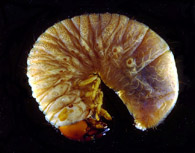
Nematodes for pest control
1981
large-scale production of worms that kill insects
Not everyone has a worm named after them! Dr Robin Bedding?s contribution to forestry was so important that the nematode (Deladenus siricidicola) he used to control the destructive Sirex wasp was renamed Beddingia siricidicola. He has also made significant contributions to agriculture and horticulture.
These industries have for many years used chemical pesticides, but their long-term environmental effects are of increasing concern. They can leave long-lasting residues that harm animals and humans; they kill non-target or beneficial insects; and they become ineffective against pest species as resistant individuals survive and breed. Problems such as these have led the agricultural and horticultural industries to seek alternative, sustainable methods of managing pests and repairing damage.
Since the 1980s, Dr Bedding and others at CSIRO Entomology have been researching ways to use nematodes to control insect pests. These are a form of biopesticide and can selectively kill pests without affecting other parts of the environment.
The team has developed and patented a system to mass-produce nematodes, store them in partially dried form for several months, and transport them to wherever the target insect is making a pest of itself. The nematodes are rehydrated and used in many different situations.
The first major success for CSIRO?s nematode technology was against the Sirex wasp, a major pest that spreads fungal infections in pine plantations. The team found and produced the only species of nematode that was effective in controlling the wasp. The development saves Australia?s pinewood industry at least $50 million a year and has been used in other countries as well.
CSIRO was the first in the world to use nematodes commercially, against black vine weevil in ornamentals from 1981 and against currant borer moth in black currants from 1983. Before the CSIRO technology was developed, mass production of nematode pesticides was limited by high costs and short shelf life.
Dr Bedding and his team have collaborated since the late 1980s with scientists in Guandong and Beijing (in China) to produce nematodes to treat the pests destroying a million hectares of apple trees.
In 2000, CSIRO signed an agreement with Ecogrow Pty Ltd to commercially produce nematodes to control scarab beetles and other turf and horticultural pests. Ecogrow will now continue the research and development program to develop better strains of nematodes and streamline production, marketing and delivery of their products.
Who Did It?
Key Organisations
CSIRO Entomology
Ecogrow Pty Ltd
Key People
Dr Robin Bedding - Chief Research Scientist
Dr Ray Akhurst - science of nematodes for Sirex, bacteriology
Ms Jackie Calder - project technologies
Mr Mike Lacey - biochemistry
Dr John Curran - ecology
Mr Tony Molyneux - ecology
Ms Simone Clark - scale-up technologies
Ms Karen Butler - storage technologies
Further Reading
Ascent Technology Magazine
March 1998, p 25-26
Links
Ecogrow Pty Ltd
CSIRO Entomology
CSIRO
Media Release
Nematodes and
Turfgrass by Dr Bedding
ABC Radio Australia Innovations August 2000
Info
on Nematodes
Entomopathogenic
nematodes
Photos of
nematodes
Personal
story of Sirex project implementation
Related Innovations
Cactoblastis moth
Nogall pest control
|













